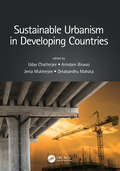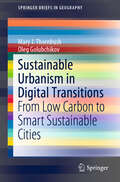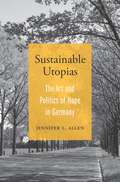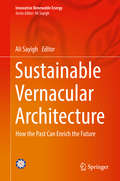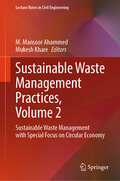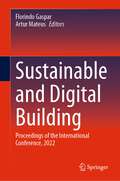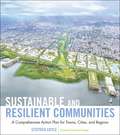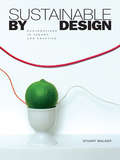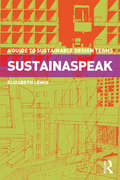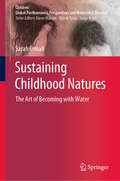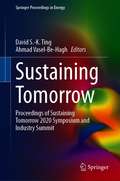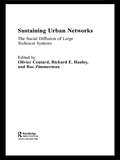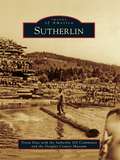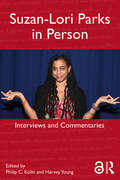- Table View
- List View
Sustainable Urbanism in Developing Countries
by Arindam Biswas Jenia Mukherjee Uday Chatterjee Dinabandhu MahataThe mushrooming of illegal housing on the periphery of cities is one of the main consequences of rapid urbanisation associated with social and environmental problems in the developing countries. Sustainable Urbanism in Developing Countries discusses the linkage between urbanism and sustainability and how sustainable urbanism can be implemented to overcome the problems of housing and living conditions in urban areas. Through case studies from India, Indonesia, China, etc., using advanced GIS techniques, this book analyses several planning and design criteria to solve the physical, social, and economic problems of urbanisation and refers to urban planning as an effective measure to protect and promote the cultural characteristics of specific locations in these developing countries. FEATURES Investigates an interdisciplinary approach to urbanism, including urban ecology, ecosystem services, sustainable landscapes, and advanced geographical systems Analyses unique case studies of rapid urbanisation from a local to a national scale in countries such as India, Sri Lanka, China, Bangladesh, Malaysia, and Indonesia and their global impact Examines the use of GIS and spatial statistics in analysing urban sprawl and the massive amount of data gathered by every operational activity of municipalities Focuses on the holistic perspective of sustainable urbanism and the harmony in the human–nature relationship to achieve sustainable development Covers a wide range of issues manifested in urban areas with economic, societal, and environmental implications contributed by leading scholars from the Global South
Sustainable Urbanism in Digital Transitions: From Low Carbon to Smart Sustainable Cities (SpringerBriefs in Geography)
by Mary J. Thornbush Oleg GolubchikovThis book examines how contemporary urbanism is influenced by digital and low carbon transitions. From its infancy at the scale of individual buildings, a focus on ‘green’ agenda, energy, and resource efficiency has fostered research and policies for low carbon cities, eco-cities, and increasingly intelligent and smarter urban systems. Cities around the world are getting ‘smarter’ as more advanced technology is integrated into urban planning and design. People are relying more on digital and information and communication technology (ICT) in their daily lives, while cities are adopting more digital technology to monitor and gather information about people and their environment. This leads to Big Data collection, which is used to inform governance and improve urban performance. These transformations, however, raise critical questions, including whether emerging smart sustainable cities are too technocratic, but also with regard to citizen involvement. This brief addresses these important contemporary concerns through a review of literature and existing urban strategies. It should be of interest to everyone involved in advancing sustainable cities and smart cities. It should also be a relevant read for students and researchers in this area.
Sustainable Use of Wood in Construction
by Jim CoulsonThere is a great deal of innovation in the use of wood in construction, from impressive modern buildings to new construction products that reduce build times and improve building performance. As a renewable resource with proven low embodied energy, wood is both an environmentally responsible and a highly practical choice as a construction material. However, forest management practices vary throughout the world: some are highly effective in delivering a sustainable, long term supply of timber; whereas others are less so, and could result in forest depletion and significant environmental degradation. Against this background, a number of certification schemes have been developed that seek to ensure that all timber is harvested from sources that are at least legally-sourced, and at best, sustainably managed. Sustainable Use of Wood in Construction explains how and why wood may be grown sustainably, and how this versatile material can be specified and - most importantly - sourced, for use in the construction industry. It explains the modern regulatory framework within Europe that seeks to eliminate the use of illegally-harvested wood, and it shows how to ensure that everyone who sells or uses wood for construction is following the rules. Finally, the book explains how, at the end of its first use in construction, wood can be recycled, by reprocessing into another wood-based construction material, or by using it as biomass. Also available Wood in Construction: How to avoid costly mistakes Jim Coulson Paperback, 978 0 4706 5777 Structural Timber Design to Eurocode 5 Second Edition Jack Porteous & Abdy Kermani Paperback, 978 0 4706 7500 7
Sustainable Utopias: The Art and Politics of Hope in Germany
by Jennifer L. AllenTo reclaim a sense of hope for the future, German activists in the late twentieth century engaged ordinary citizens in innovative projects that resisted alienation and disenfranchisement. By most accounts, the twentieth century was not kind to utopian thought. The violence of two world wars, Cold War anxieties, and a widespread sense of crisis after the 1973 global oil shock appeared to doom dreams of a better world. The eventual victory of capitalism and, seemingly, liberal democracy relieved some fears but exchanged them for complacency and cynicism. Not, however, in West Germany. Jennifer Allen showcases grassroots activism of the 1980s and 1990s that envisioned a radically different society based on community-centered politics—a society in which the democratization of culture and power ameliorated alienation and resisted the impotence of end-of-history narratives. Berlin’s History Workshop liberated research from university confines by providing opportunities for ordinary people to write and debate the story of the nation. The Green Party made the politics of direct democracy central to its program. Artists changed the way people viewed and acted in public spaces by installing objects in unexpected environments, including the Stolpersteine: paving stones, embedded in residential sidewalks, bearing the names of Nazi victims. These activists went beyond just trafficking in ideas. They forged new infrastructures, spaces, and behaviors that gave everyday people real agency in their communities. Undergirding this activism was the environmentalist concept of sustainability, which demanded that any alternative to existing society be both enduring and adaptable. A rigorous but inspiring tale of hope in action, Sustainable Utopias makes the case that it is still worth believing in human creativity and the labor of citizenship.
Sustainable Value Management for Construction Projects
by Ayodeji E. Oke Clinton O. AigbavboaThis book provides a unique guide to value management and sustainability in construction to researchers and professional. The book provides a better understanding of the concept of value management, the basis of sustainable construction and thereafter, demonstrates how using the principles of value management can help to achieve successful construction projects that are financially viable, socially beneficial and do not damage the environment.The book serves as an introduction to value management for scholars and researchers at all levels; and also as a practical guide for construction professionals, employers and other stakeholders in the construction industry.
Sustainable Vernacular Architecture: How the Past Can Enrich the Future (Innovative Renewable Energy)
by Ali SayighThis book discusses applying vernacular strategies to modern architectural design to adhere to basic green principles of energy efficiency and materials utilization. Written from an international perspective, chapters present the perspectives and experiences of architects and engineers from across the globe. Historically successful approaches are integrated with modern design concepts to create novel, sustainable, and resource conscious solutions. The scope of topics covered include natural ventilation, cooling and heating, daylight and shading devices, and green micro-climate and functional facades, making this a useful reference for a wide range of researchers and workers in the built environment.Covers the most up-to-date research developments, best practices, and innovations from countries all over the globe;Presents the latest research in vernacular architecture and sustainable building;Contains case studies and examples to enhance practical application of the technologies presented.
Sustainable Waste Management Practices, Volume 2: Sustainable Waste Management with Special Focus on Circular Economy (Lecture Notes in Civil Engineering #732)
by Mukesh Khare M. Mansoor AhammedThis book is a proceedings of a conference &“International Conference on Environmental Science and Engineering&” to be held in Surat during December 2024. The theme of the conference include Pollution Modelling Sustainable Development and SDGs Climate Chemistry and Climate Change Environmental, Social and Governance Waste Characterization and Treatment Circular Economy and Environmental Impacts Control Strategies for Water, Waste, Air and Noise Application of AI/ML in Environmental Engineering Air, Water and Noise—Quality Monitoring and Measurement Techniques.
Sustainable Waste Utilization in Bricks, Concrete, and Cementitious Materials: Characteristics, Properties, Performance, and Applications (Lecture Notes in Civil Engineering #129)
by Shahiron Shahidan Aeslina Abdul Kadir Noor Amira SaraniThis book highlights the current research, conceptual and practical utilization of waste in building materials. It examines the production of industrial and agricultural wastes that have been generated worldwide and have significant environmental impact. The book discusses how to incorporate these wastes effectively with greener technology and how to address its environmental impact in order to produce environmentally friendly and sustainable green products. This book also will capitalize on its practical application, properties, performance and economic advantages. The topics covered include the physical, mechanical and environmental properties, leaching behaviour, gas emissions and performance of sustainable construction materials. This book offers a valuable reference for researchers, industries and interested stakeholders in sustainable construction or any allied fields.
Sustainable and Digital Building: Proceedings of the International Conference, 2022
by Florindo Gaspar Artur MateusThis book presents the Proceedings of the International Conference on Sustainable and Digital Building, at Marinha Grande, Portugal held in October 2022. The Conference created a forum for discussion of a range topics on this broad area, including building materials, building processes, digital technologies, and building sustainability. A major focus of the collection is green building throughout a structure’s life-cycle—from planning to design, construction, operation, maintenance, renovation, and demolition. In addition, the Conference examined industry making the transition to digital transformation of buildings, a key benchmark to realizing European climate goals and achieving net-zero carbon buildings by 2050.
Sustainable and Emerging Energy Technology: Challenges, Opportunities, and Perspectives (Green Energy and Technology)
by Xiaolin WangSustainable and Emerging Energy Technology: Challenges, Opportunities, and Perspectives presents advanced technologies and research results in theoretical, experimental, and practical sustainable and emerging energy engineering. Contributions cover theoretical analyses and case studies to explore new concepts, technological advancements, and practical applications to help engineers and researchers better understand the relevant concepts and solutions necessary to achieve global Sustainable Development Goals. The book brings together the latest developments in the emerging areas of renewable systems and technologies, green energy buildings, intelligent power systems, microgrids, energy storage, and security. Coverage includes: Renewable energy systems and applications; Power generation and efficiency; Power transmission, distribution, and control; Power grids and microgrids; Energy storage and conversion; Energy efficiency in conventional and renewable energy systems; Energy systems for buildings; Integration of renewable energy sources in buildings; Greening urbanization and urban settlements. This book is a valuable resource offering practical approaches to help engineers and researchers in sustaina
Sustainable and Regenerative Materials for Architecture: A Sourcebook
by Pete Silver Will McLeanThere is a creative explosion of work taking place in architecture and design schools exploring materials such as mycelium, clay/earth, engineered timber, bio-based plastics and algae. This handbook of low- and no-carbon materials for architects and designers focuses on sustainable materials, their sourcing, technical properties and the processes required for their use in architecture. The book showcases new and rediscovered processes for material fabrication, responsible sourcing and creative material design. Material properties (structural, thermal, fire, health and life safety) are described and case studies from around the world illustrate the inventive ways in which these materials have been deployed in the built environment. The book is designed as an introduction to the exciting and rapidly changing world of construction materials.With a better understanding of the social, environmental and economic sustainability of any given material - alongside its technical properties - students of architecture can lead the change in responsible and creative material use.CONTENTS1 Materials overview2 Extractive materials: earth and clay concrete stone metals glass3 Grown materials: timber and cork paper hemp bamboo seaweed mycelium algae biopolymers wool
Sustainable and Regenerative Materials for Architecture: A Sourcebook
by Pete Silver Will McLeanThere is a creative explosion of work taking place in architecture and design schools exploring materials such as mycelium, clay/earth, engineered timber, bio-based plastics and algae. This handbook of low- and no-carbon materials for architects and designers focuses on sustainable materials, their sourcing, technical properties and the processes required for their use in architecture. The book showcases new and rediscovered processes for material fabrication, responsible sourcing and creative material design. Material properties (structural, thermal, fire, health and life safety) are described and case studies from around the world illustrate the inventive ways in which these materials have been deployed in the built environment. The book is designed as an introduction to the exciting and rapidly changing world of construction materials.With a better understanding of the social, environmental and economic sustainability of any given material - alongside its technical properties - students of architecture can lead the change in responsible and creative material use.CONTENTS1 Materials overview2 Extractive materials: earth and clay concrete stone metals glass3 Grown materials: timber and cork paper hemp bamboo seaweed mycelium algae biopolymers wool
Sustainable and Resilient Communities
by Coyle Stephen J. Duany Andr 233 SThe ultimate step-by-step action plan guidebook for making communities resilient, resourceful, and healthy Many of today's communities face an unprecedented struggle to adapt and maintain their environmental, economic, and social well-being in an era beleaguered by fiscal constraints, uncertainty about energy prices and supplies, rapid demographic shifts, and accelerated climate impacts. This step-by-step guidebook for urban planners and urban designers explains how to create and implement an actionable plan for making neighborhoods, communities, and regions more environmentally healthy, resource-conserving, and economically resilient. Sustainable and Resilient Communities delineates measures for repairing, retrofitting, and transforming our built environments and supporting systems-transportation, energy, water, natural environment, food production, solid waste, and economics-through: Methods for assessing a community's key sustainability quotient Deploying tools for establishing timely performance goals and metrics Developing strategies for evaluating, selecting, and implementing 'high-leverage' interventions Activating policies, codes, programs, plans, and practices, as well as monitoring and upgrading their performance The book includes a range of targeted case studies, from New Orleans and South Carolina to Arizona and California, illustrating geographically diverse approaches for urban contexts large and small. A resource for developing an ecological urbanism, Sustainable and Resilient Communities employs time-proven, broadly applicable strategies and actions that can be customized for specific environmental, energy, and economic conditions.
Sustainable and Smart Spatial Planning in Africa: Case Studies and Solutions
by Walter Timo de Vries Charles Chavunduka Pamela Durán-DíazThis book clarifies the smart city concept that is gaining application in Sub – Saharan Africa. It shows how the smart concept can be used to address problems that would be difficult and more expensive to solve using traditional techniques such as employment creation. This is done through elaboration of the African interpretation of smartness, using tools for smart solid waste management, e-governance, smart energy, and smart infrastructure. The case studies selected, and each chapter explain a different dimension of the smart city concept and offer innovative solutions to problems of rapid urbanization. It lays the theoretical foundation for further research on smart cities and rural areas in Africa.
Sustainable by Design: Explorations in Theory and Practice
by Stuart WalkerTo advance the subject of design one has to engage in the activity of designing. Sustainable by Design offers a compelling and innovative, design-centred approach that explores both the meaning and practice of sustainable design. Walker explores the design process in the context of sustainability, and challenges conventional ways of defining, designing and producing functional objects. He discusses the personal design process, tacit knowledge, ephemeral design, experimental design, and the relationship between intellectual design criteria, physical expression and aesthetic experience. This book will introduce vital concepts to students and will inspire designers by providing a well-articulated basis for understanding the complexity and potential of sustainable design, and extolling the contribution of design to the creation of a more meaningful material culture.
Sustainaspeak: A Guide to Sustainable Design Terms
by Elizabeth LewisArchitecture 2030; BUG; Biophilic Design; BIPV; Circular Economy; LEED; Passive Design; Solar Chimney; Systems Thinking; WELL; Xeriscaping. What does it all mean? The complex and evolving language used in the sustainable design community can be very challenging, particularly to those new to environmentally friendly and resource-efficient design strategies that are needed today. Definitions of over two hundred terms with further sources. Clearly cross-referenced with Sustainaspeak, Theoryspeak, and Archispeak terms. Illustrated throughout with sustainable award-winning buildings by e.g. Behnisch, Brooks + Scarpa, EHDD, KieranTimberlake, Lake|Flato, Leddy Mahtum Stacy, SmithGroup, Perkins+Will, ZGF, VMDO, and McDonough + Partners. Sustainaspeak: A Guide to Sustainable Design Terms provides a current guide to the sustainable design strategies, terms, and practices needed for the next generation of designers, architects, students, and community leaders to design a carbon-neutral world for future generations.
Sustaining Childhood Natures: The Art of Becoming with Water (Children: Global Posthumanist Perspectives and Materialist Theories)
by Sarah CrinallThis book examines sustainability learning with children, art and water in the new material, posthuman turn. A query into how we might sustain (our) childhood natures, the spaces between bodies and places are examined ontologically in daily conversations. Regarding philosophy, art, water and her children, the author asks, how can I sustain waterways if I am not sustaining myself?Theoretically disruptive and playful, the book introduces a new philosophy that combines existing philosophies of the new material and posthuman kind. The ecological sciences, and the arts, are drawn together / apart to help recognize sustainability in its emergent, relational form. All the while this book, as art, engages and flows over the reader – as such, reading it becomes a transformative, meditative experience. Daily rhythms of ‘being-with’ art, water and children take the reader beyond orientations of environmental education that focus on notions of lack and reduction. New possibilities for sustaining childhood natures – for what is becoming, and unbecoming – emerge here in the making processes of an academic, everyday life in early motherhood.
Sustaining Cultural Development: Unified Systems and New Governance in Cultural Life
by James Doyle Biljana MickovIn Sustaining Cultural Development, Biljana Mickov and James Doyle argue that effective programmes to promote greater participation in cultural life require substantial investment in research and strategic planning. Using studies from contributors throughout Europe, they look at ways to promote cultural life as the centre of the broader sustainable development of society. These studies illustrate how combining cultural identity, cultural diversity and creativity with increased participation of citizens in cultural life improves harmonized cultural development and promotes democracy. They indicate a shift from traditional governance of the cultural sector to a new, more horizontal, approach that links cultural workers at different levels in different sectors and different locations. This book will stimulate debate amongst cultural leaders, city managers and other policy makers, as well as serving as a resource for researchers and those teaching and learning on a range of post-graduate courses and programmes.
Sustaining Resources for Tomorrow (Green Energy and Technology)
by David S.-K. Ting Jacqueline A. StagnerThis book reflects the current state of knowledge on sustainability in a wide range of fields, from engineering to agriculture, to education. Though primarily intended to offer an update for experts and researchers in the field, it can also be used as a valuable educational tool for relevant undergraduate and graduate courses. Key aspects covered include the better and more responsible engineering and management of energy conversion processes, the development of renewable energy technologies, and improvements in conventional energy utilization and food production. In addition, the book addresses green buildings, the green economy, waste and recycling, water, ecopolitics and social sustainability.
Sustaining Tomorrow: Proceedings of Sustaining Tomorrow 2020 Symposium and Industry Summit (Springer Proceedings in Energy)
by David S.-K. Ting Ahmad Vasel-Be-HaghThis book includes the proceedings of the Sustaining Tomorrow 2020 symposium and summit which bring together research from experts in academia, industry, and policy arenas to uncover the challenges and to forge solutions to sustain tomorrow. To sustain tomorrow, we need to continuously make headway in Agriculture, Engineering, Energy, Environment, Economics, Water, among other necessities. This book disseminates the most recent advances in these fields and promotes collaborations to maximize opportunities for innovative solutions.Though primarily intended to offer an update for experts and researchers in the field, this book is equally useful as a valuable educational tool for relevant undergraduate and graduate courses. Key aspects covered include the better and more responsible engineering and management of energy conversion and conservation processes, the furthering of renewable energy technologies, improvements in water-agriculture nexus and energy-environment-economics relationship, and endorsing education, implementation, and evaluation of all-embracing sustainability.
Sustaining Urban Networks: The Social Diffusion of Large Technical Systems (Networked Cities Series)
by Olivier Coutard Rae Zimmerman Richard E. HanleyConsidering sustainability in its economic, environmental and social contexts, the contributors take stock of previous research on large technical systems and discuss their sustainability from three main perspectives: uses, cities, and rules and institutions.
Sutherlin
by Douglas County Museum Tricia Dias Sutherlin 100 CommitteeOriginally called Camas Swale, Sutherlin was incorporated on June 24, 1911, and renamed for Fendel Sutherlin at the behest of his daughter, Anne Sutherlin Waite. What started as an agricultural community of orchard homesites later transitioned into a timber boomtown during World War II. Although the Sutherlin valley had its share of visionaries, most of its people were basic, hardworking folks who persevered despite the roadblocks in their way. They survived floods, fires, destruction of the timber industry by the spotted owl conflict, wholesale unemployment, and the 1989 shutdown of the city for lack of funds. Today's residents are also hardy people, even the newer senior citizens who, in great numbers, are making the town their retirement home.
Sutton
by Chris SinacolaSutton was born among fertile hilltops and well-watered valleys of the Nipmuc country, where, in the early 1700s, a group of London proprietors established a new foothold in America. In the wake of Indian wars, English farmers built a town on their guns, plows, and Congregational sensibilities, a place echoed today through the images in Sutton. No Massachusetts town sent more of its native sons to fight for independence, and Sutton secured that liberty through hard work. French Canadian workers built the mill villages of Manchaug and Wilkinsonville and turned out cloth, hats, and shuttles. Sutton raised prize-winning cattle and grew the Sutton Beauty apple. As the twentieth century brought growth, Sutton blended highways and subdivisions with eighteenth-century homes, farms, and a working blacksmith shop.
Suzan-Lori Parks in Person: Interviews and Commentaries
by Philip C. Kolin Harvey YoungThis collection of interviews offers unprecedented insight into the plays and creative works of Suzan-Lori Parks, as well as being an important commentary on contemporary theater and playwriting, from jazz and opera to politics and cultural memory. Suzan-Lori Parks in Person contains 18 interviews, some previously untranscribed or specially undertaken for this book, plus commentaries on her work by major directors and critics, including Liz Diamond, Richard Foreman, Bonnie Metzgar and Beth Schachter. These contributions combine to honor the first African American woman to receive the Pulitzer Prize in drama, and explore her ideas about theater, history, race, and gender. Material from a wide range of sources chronologically charts Parks’s career from the 1990s to the present. This is a major collection with immediate relevance to students of American/African-American theater, literature and culture. Parks’s engaging voice is brought to the fore, making the book essential for undergraduates as well as scholars.
Suzan-Lori Parks: A Casebook (Casebooks on Modern Dramatists)
by Kevin J. Wetmore Jr Alycia Smith-HowardSuzan-Lori Parks confirmed herself as one of the most exciting and successful playwrights of her generation when her work Topdog/Underdog was awarded the 2002 Pulitzer Prize, making her the only African American woman to win the award. Despite the cultural weight of this achievement, Parks remains difficult both to pigeonhole and to summarize. This volume seeks to provide a context for her work, with essays from major and emerging scholars addressing the importance of factors such as gender, ethnicity, language and history in plays from her first major work, Imperceptible Mutabilities of the Third Kingdom to the 365 Days / 365 Plays project. Suzan-Lori Parks: A Casebook represents the first major study of this unique voice in contemporary drama. Contributors: Leonard Berkman, Jason Bush, Shawn Marie-Garrett, Andrea Goto, Heidi Holder, Barbara Ozieblo, Kevin J. Wetmore Jr and Harvey Young. Kevin J. Wetmore Jr is Professor of Theatre at Loyola Marymount University, as well as being a professional actor and director of the Comparative Drama Conference. He is the author of The Athenian Sun in an African Sky and Black Dionysus: Greek Tragedy and African American Theatre. Alycia Smith-Howard an Assistant Professor at New York University in the Gallatin School of Individualized Study, where she is the Artistic Director of the Gallatin Arts Festival and the Book Reviews Editor at the New England Theatre Journal. A Fellow of the Folger Shakespeare Library, her areas of specialization include Shakespeare, performance history, feminist theatre aesthetics and literature and drama of the south.
